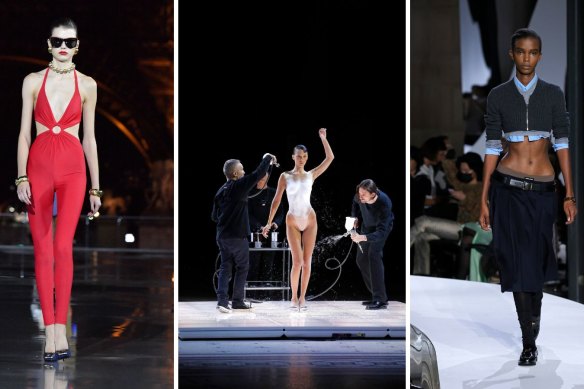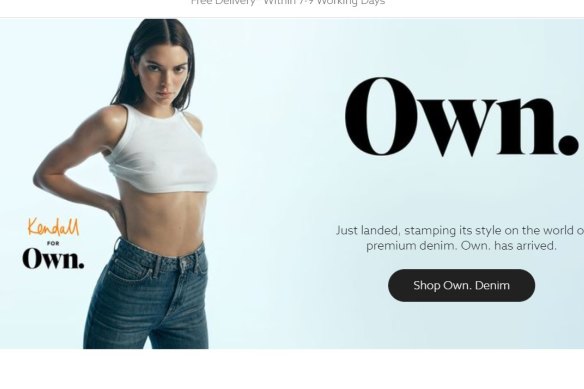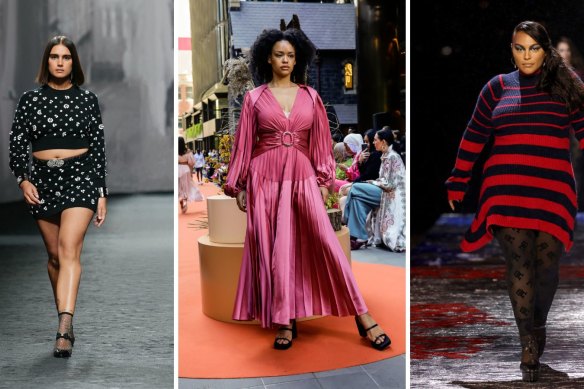This was published 2 years ago
After years of progress, are ultra-thin models making a fashion comeback?
The runways of fashion weeks showed some promise and some disappointing throwbacks. Fashion editor Melissa Singer and style editor Damien Woolnough discuss.
By Melissa Singer and Damien Woolnough
The ready-to-wear runways are over for another season, and as people invariably pick over the entrails of the various stunts, controversies and some truly beautiful clothes, the question of diversity – particularly the size of the models – is once again bubbling up.
While some shows, including Chanel, Tommy Hilfiger, Balmain and Chloé, showed great promise and progress, others appeared to snap back to pre-pandemic times, leading some commentators to bemoan the return of “thin worship” to the international catwalks.
To dissect whether fashion is regressing when it comes to size diversity, or whether there are just a few bad apples in a barrel of promise, fashion editor Melissa Singer and style editor Damien Woolnough have taken their front-row seat.

Across the runway season, thin models were back on catwalks after years of change.Credit: Getty
Melissa: So, Damien, I am usually the last person to bang on about skinny models but a few things have happened this week to make me think we need to have this discussion. A writer I follow, Tyler McCall, was calling out a lot of skinny models on the Paris runways, especially at Miu Miu and Dolce & Gabbana (although she did also praise the latter for including more than one ‘regular’ sized model); then a colleague with three teenage daughters contacted me to say she was quite distressed about one brand’s models; and last night, I went online looking for clothes for my one-year-old, and the first thing I saw on a popular website was an image of a rake-thin Kendall Jenner in a crop top and jeans. So you could say thin-ness is top of mind.
Damien: This is a discussion older than 91-year-old, rail thin supermodel Carmen Dell’Orefice but an important one. We have seen progress towards size diversity but it is slow. I think you’re right in noting that size diversity didn’t have the traction of past seasons. It was hard to get past traditionally sized model Bella Hadid being sprayed by three men with a robot on the Coperni runway and Ye’s political prodding.

Kendall Jenner on the Next homepage.
Melissa: Oh, gosh, don’t even get me started on everything I found problematic with that Bella Hadid stunt.
Damien: The European runways did look jarring after New York, where there were more than one token plus-size model in a stretchy dress championing designers. Tommy Hilfiger’s runway was packed with plus-size male and female models and the Vogue World show was surprisingly inclusive.
Melissa: Yes, you were at New York Fashion Week. Did people there still talk about size diversity, or is it just integrated now? I kind of wish we weren’t having this chat, as much as I am enjoying it.
Damien: People are still talking about it because the dedicated plus-size show at Australian Fashion Week this year clearly demonstrated the appetite for people to see themselves on the runway. It was interesting talking to plus-size influencer Margie Plus about how the social media space is now moving faster than the runways at bringing people into the luxury fold. On social media they don’t have to wear the boring oversized dress but can rock the sexiest numbers available.
Melissa: Maybe I am just more sensitive to this stuff since, you know, becoming a parent. To a girl.
Damien: As an uncle I can relate. Taking my niece to a runway show at Melbourne Fashion Festival in March, I was relieved to see women of all sizes on the runway. The only potential long-term damage being done was by some of the clothes.

Models for Chanel, Acler at Melbourne Fashion Week, and Tommy Hilfiger in New York.Credit: Getty
Melissa: Well, we can’t have everything. But on the whole, I think the Australian fashion weeks seem to have got it right. I was at the opening of Melbourne Fashion Week on Monday and it was good to see its tradition of diverse casting continue. Models! With jiggly bits! I mean, it’s not that hard.
Damien: When I was in New York I felt proud of the progress Australia has made since Robyn Lawley started championing models who look as though they eat. It is disturbing to see how fixed some brands are by the almost androgynous image of a skinny female. Louis Vuitton and Saint Laurent need to move beyond seeing models as living line drawings.
Melissa: Yes, even in our post-Karl Lagerfeld world there are still brands sorely behind on this. I worry that the resurgence of Y2K-style low-rise waistlines has given brands like Miu Miu a virtual licence to showcase horribly thin models. It’s as if they’re throwing their hands up and saying, “Do you have a problem?” And while I have almost come to expect this from some luxury brands, seeing Kendall Jenner’s exposed ribs splashed across a mainstream retailer like Next was the last straw for me this time.
Damien: I wonder what happened to all of those resolutions made by the industry in 2012 about not working with models that are too thin? I think that supermodel Coco Rocha has helped advocate for model health but we are still seeing too many exposed ribcages on young women who have exhausted themselves walking the runways of New York, London, Milan and Paris. I had hoped that bringing older models onto the runway would help promote greater change but with the exception of a cloaked Linda Evangelista at Fendi, it’s senior models that have stayed thin who book the big gigs.
Melissa: That’s such an interesting observation. So you can have age diversity, or size diversity, but maybe not both?
Damien: And what about ability diversity? Perhaps everyone is still too busy patting themselves on the back after tackling racial diversity with greater success?
Bella Hadid’s spray-on dress stunt went viral.Credit: Youtube: iDest
Melissa: Well, we know how long that took. So I guess what you’re saying is I’d better start preparing myself for those body-image conversations with my girl. And maybe find a new source for baby clothes if I don’t want to be smacked in the eyes with Jenner’s underboob.
Damien: I’m curious – if your daughter wanted to model, what changes would you have to see in the industry before you said “yes”?
Melissa: Great question. Better regulation of agents, some kind of safety officer on jobs wherever models are underage … but really, change has to come from the top down. Chanel gave me some hope; let’s hope it’s not just a flash in the pan.
Damien: Let’s hope by the time she’s old enough this conversation is no longer fashionable.
Melissa: Amen.
Make the most of your health, relationships, fitness and nutrition with our Live Well newsletter. Get it in your inbox every Monday.